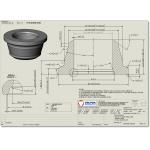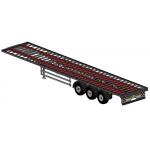Latest News
January 1, 2007
By Al Dean
If there’s a single challenge that’s facing the design, engineering, and manufacturing industry, it’s the bleed of knowledge — whether from outsourcing to lower-cost economies or from an aging workforce. So, to combat both aspects, you need to be able to work smarter, harder, and more efficiently than ever before. While technology isn’t the panacea marketers would have you believe, when it comes to knowledge drain, technology can help — on two fronts. First, by capturing in-house knowledge and expertise in a rules-based design system and, second, by automating routine process and design tasks thereby allowing your design team to concentrate on innovation rather than iteration.
 |
| Image courtesy of DriveWorks Ltd. |
> > DriveWorks can generate a variety of outputs that you need to both manufacture and market product variants. It takes care of mundane tasks so you can innovate.
While many systems currently available work on this premise, one system that can assist those within the SolidWorks user community is DriveWorks. Based in the UK, but well placed within the global VAR channel, at its root level, DriveWorks uses a combination of its own rules capture and re-use technology integrated to SolidWorks. This enables an organization to capture the design rules that govern the development of a product variant; then use those rules to create a front end that lets you create a form-based user interface in which you specify the customer’s requirements. The system takes these inputs, variants, and parameters and drives the creation of the product model, along with all the documentation, annotation, and such — in an automated manner.
Making the Complex Accessible
So, how do you go about capturing that data? Unlike other knowledge-based design systems, DriveWorks places the creation and maintenance of those critical design rules in the hands of the engineer, rather than some “by the hour” consultant. The whole process is done with a combination of a SolidWorks add-in to capture parameters and variants relating to the geometry and DriveWorksAdministrator, which uses parameters and variants to create the intelligence that links all those parameters up using all manner of equations and calculation strings.
 |
| Image courtesy of DriveWorks Ltd. |
< < DriveWorks automates many of the repetitive design engineering tasks.
Another key component of DriveWorks is the set of tools to assist in building a front end to the automation process. What DriveWorks allows you to do is take what can potentially be complex design processes and geometry files, and drive their creation using common, accessible language. So rather than adapting an MCAD model using cryptic relationships (think ‘D1=2*<P2/2+D143’), you define it in common language for your product — length, weight handling, power output — whatever that may be.
As a product suite, DriveWorks has been configured to allow you to dip a proverbial toe into the rules-based design automation process, and then expand how that system is used, both in terms of functionality and how it’s deployed within your organization.
The root level offering is DriveWorksEngineer, which offers the basic rules-based automation tools that integrate within the SolidWorks. It allows you to capture design rules for built-to-order products and use that data to automate the design of common product variants. The offering includes a DriveWorks seat for using those rules and a DriveWorksAdministrator seat for the actual capture of the rules. DriveWorksEngineer is sold as a single seat (including both tools) and is effectively the entry-level product.
The concept is that DriveWorksEngineer is used alongside SolidWorks. It allows you to specify and configure a product using the rules you’ve captured to assist with automating the development and preparation of a product for manufacture — essentially, it’s a designer’s tool.
The next level up, DriveWorksTeam builds on these design rules with capture and automation tools to allow multiple users to access that information in a server-based environment.
The high-end offering is DriveWorksEnterprise. This includes all of the tools we’ve discussed, but includes additional facilities allowing that data to be distributed through your enterprise — by allowing access to your design-rules-based system in a Web-based environment. This takes DriveWorks out of the design office and puts it into the hands of whoever needs it; whether that’s sales staff accessing the system in a mobile environment, or offering your customers the ability to specify their own products over the Web. When that quotation is created, the benefit is that rather than just capturing user specification in an intelligent manner, the system is also generating all of the 3D and 2D documentation. So when the order is placed, all of the repetitive and, in many cases, mundane tasks that take up a massive amount of time and effort within an engineer-to-order business are taken care of. In addition to this, DriveWorksEnterprise allows an organization to integrate the rules-based design of suitable products to be integrated with your existing business systems, whether that’s PDM, ERP or CRM.
I guess the final question is why should you adopt a system like this? The short answer is that if you have products within your organization that are iterated on a regular basis and that iteration can be defined by a set of rules, then DriveWorks can assist with automating the design and documentation of those entire products. DriveWorks allows you to take a repetitive process that many engineers and designers engage in on a daily and weekly basis and automate it. Some users might see this as an excuse for management to downsize their team, but the facts are that by adopting an intelligent system like DriveWorks — a system that automates the mundane and repetitive tasks, including modeling as well as documentation variants of standard products — allows you to solve the interesting design challenges and look for new areas of improvement or expansion.
From a business management perspective, DriveWorks provides a method of optimizing your product development processes — if you regularly deal with configurable or variant-driven products. Why have your design team spending needless hours iterating the design of pretty much the same parts or assemblies, when you can offload that work to DriveWorks, even offloading the input to sales staff (using the Enterprise-level offering)? This allows your design or engineering team to look at the complex problems that always arise. More importantly, it frees you to investigate new products and drive your business through innovation rather than iteration of the same products that provide the bread and butter.
Al Dean is Technology Editor of the UK’s leading product development and manufacturing journal, MCAD and is Editor of Prototype, for the rapid prototyping and direct manufacturing industry, both available by clicking here. Send your comments about this article through e-mail by clicking here. Please reference “DriveWorks” in your message.
Contacts
DriveWorks Ltd.
Thelwall, Cheshire, UK
SolidWorks Corp.
Concord, MA
Subscribe to our FREE magazine, FREE email newsletters or both!
Latest News
About the Author
DE’s editors contribute news and new product announcements to Digital Engineering.
Press releases may be sent to them via [email protected].






